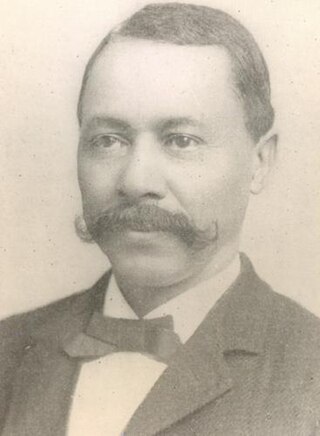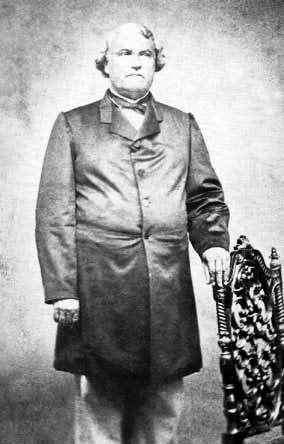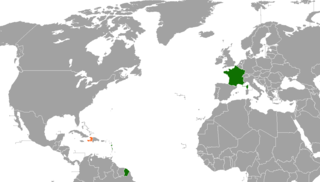The recorded history of Haiti began in 1492, when the European captain and explorer Christopher Columbus landed on a large island in the region of the western Atlantic Ocean that later came to be known as the Caribbean. The western portion of the island of Hispaniola, where Haiti is situated, was inhabited by the Taíno and Arawakan people, who called their island Ayiti. The island was promptly claimed for the Spanish Crown, where it was named La Isla Española, later Latinized to Hispaniola. By the early 17th century, the French had built a settlement on the west of Hispaniola and called it Saint-Domingue. Prior to the Seven Years' War (1756–1763), the economy of Saint-Domingue gradually expanded, with sugar and, later, coffee becoming important export crops. After the war which had disrupted maritime commerce, the colony underwent rapid expansion. In 1767, it exported indigo, cotton and 72 million pounds of raw sugar. By the end of the century, the colony encompassed a third of the entire Atlantic slave trade.

Henri Christophe was a key leader in the Haitian Revolution and the only monarch of the Kingdom of Haiti.

Jean-Pierre Boyer was one of the leaders of the Haitian Revolution, and the president of Haiti from 1818 to 1843. He reunited the north and south of the country into the Republic of Haiti in 1820 and also annexed the newly independent Spanish Haiti, which brought all of Hispaniola under one Haitian government by 1822. Serving as president for just under 25 years, Boyer managed to rule for the longest period of time of any Haitian leader.

Alexandre Sabès Pétion was the first president of the Republic of Haiti from 1807 until his death in 1818. One of Haiti's founding fathers, Pétion belonged to the revolutionary quartet that also includes Toussaint Louverture, Jean-Jacques Dessalines, and his later rival Henri Christophe. Regarded as an excellent artilleryman in his early adulthood, Pétion would distinguish himself as an esteemed military commander with experience leading both French and Haitian troops. The 1802 coalition formed by him and Dessalines against French forces led by Charles Leclerc would prove to be a watershed moment in the decade-long conflict, eventually culminating in the decisive Haitian victory at the Battle of Vertières in 1803.

Benoit Joseph André Rigaud was the leading mulatto military leader during the Haitian Revolution. Among his protégés were Alexandre Pétion and Jean-Pierre Boyer, both future presidents of Haïti.

Ebenezer Don Carlos Bassett was United States Ambassador to Haiti from 1869 to 1877. He was the first African American diplomat and the fourth U.S. ambassador to Haiti since the two countries established relations in 1862. His mother was Pequot. From 1857 to 1869 he was the principal of the Institute for Colored Youth in Philadelphia.

Guillaume Fabre Nicolas Geffrard was a mulatto general in the Haitian army and President of Haiti from 1859 until his deposition in 1867. On 18 April 1852, Faustin Soulouque made him Duke of Tabara. After collaborating in a coup to remove Faustin Soulouque from power in order to return Haiti to the social and political control of the colored elite, Geffrard was made president in 1859. To placate the peasants he renewed the practice of selling state-owned lands and ended a schism with the Roman Catholic Church which then took on an important role in improving education. After surviving several rebellions, he was overthrown by Major Sylvain Salnave in 1867.

Thomas Madiou was a Haitian historian. His work Histoire d'Haïti is the first complete history of Haiti from 1492 to 1846. It is considered one of the most valuable documents of Haitian history and literature.

Pierre Joseph Marie Granville, known as Jonathas Granville (1785–1839) was a Haitian educator, legal expert, soldier and a diplomat. He was born a free mulatto in Saint-Domingue. He was a musician and poet, skilled swordsman, an experienced diplomat, and civil servant. From about 1806 to 1815, Granville served under Napoleon as a junior officer during the emperor's campaigns in Germany, France, and Austria. After the Bourbon Restoration, he returned to Haiti with his mother and sisters where he quickly entered in the service of Alexandre Pétion's government. In 1824 he visited the United States, to promote the emigration of free Blacks to Haiti. At his return, in 1825, he established a private school, which will become known as the Granville Institute, before being asked to lead the National Lycee in Port-au-Prince. He is considered to be the intellectual father of the 1843 Revolution that finally dislodged Jean-Pierre Boyer's authoritarian regime. Granville was regarded as well-educated and refined, a man of knowledge and virtue. He made popular in the U.S. the Persian saying, "I write insults on sand and favours on marble."

Loring Daniel Dewey (1791–1867) was an early 19th-century Presbyterian minister, an agent of the American Colonization Society, an active supporter of colonization societies, a printer, and a reformer.

The Kingdom of Haiti, or Kingdom of Hayti was the state established by Henri Christophe on 28 March 1811 when he proclaimed himself King Henri I after having previously ruled as president of the State of Haiti, in the northern part of the country. This was Haiti's second attempt at monarchical rule, as Jean-Jacques Dessalines had previously ruled over the First Empire of Haiti as Emperor Jacques I from 1804 until his assassination in 1806.
The Republic of Haiti is located on western portion of the island Hispaniola in the Caribbean. Haiti declared its independence from France in the aftermath of the first successful slave revolution in the Americas in 1804, and their identification as conquerors of a racially repressed society is a theme echoed throughout Haiti's history.

The Haitian occupation of Santo Domingo was the annexation and merger of then-independent Republic of Spanish Haiti into the Republic of Haiti, that lasted twenty-two years, from February 9, 1822, to February 27, 1844. The part of Hispaniola under Spanish administration was first ceded to France and merged with the French colony of Saint Domingue as a result of the Peace of Basel in 1795. However, with the outbreak of the Haitian Revolution the French lost the western part of the island, while remaining in control of the eastern part of the island until the Spanish recaptured Santo Domingo in 1809.

The Haiti Independence Debt involves an 1825 agreement between Haiti and France that included France demanding an indemnity of 150 million francs to be paid by Haiti in claims over property – including Haitian slaves – that was lost through the Haitian Revolution in return for diplomatic recognition, with the debt removing $21 billion from the Haitian economy. The first annual payment alone was six times Haiti's annual revenue. The payment was later reduced to 90 million francs in 1838, equivalent to $34,000,000,000 in 2023, with Haiti paying about 112 million francs in total. Over the 122 years between 1825 and 1947, the debt severely hampered Haitian economic development as payments of capital and interest totaled a significant share of Haitian GDP, constraining the use of domestic financial funds for infrastructure and public services.

Pierre Théoma Boisrond-Canal was a Haitian politician who served as the president of Haiti three times.

The Haitian Declaration of Independence was proclaimed on 1 January 1804 in the port city of Gonaïves by Jean-Jacques Dessalines, marking the end of 13-year long Haitian Revolution. The declaration marked Haiti becoming the first independent nation of Latin America and only the second in the Americas after the United States.

Thomas Paul (1773–1831) was a Baptist minister in Boston, Massachusetts, who became the first pastor for the First African Baptist Church, currently known as the African Meeting House. He later helped found the Abyssinian Baptist Church in New York City. An abolitionist, he was a leader in the black community and was an active missionary in Haiti.

France–Haiti relations are foreign relations between France and Haiti. Both nations are members of the Organisation internationale de la Francophonie, United Nations, and the World Trade Organization.

The Indigenous Army, also known as the Army of Saint-Domingue was the name bestowed to the coalition of anti-slavery men and women who fought in the Haitian Revolution in Saint-Domingue. Encompassing both black slaves, maroons, and affranchis, the rebels were not officially titled the Armée indigène until January 1803, under the leadership of then-general Jean-Jacques Dessalines. Predated by insurrectionists such as François Mackandal, Vincent Ogé and Dutty Boukman, Toussaint Louverture, succeeded by Dessalines, led, organized, and consolidated the rebellion. The now full-fledged fighting force utilized its manpower advantage and strategic capacity to overwhelm French troops, ensuring the Haitian Revolution was the most successful of its kind.

The Republic of Haiti from 1820 to 1849 was effectively a continuation of the first Republic of Haiti that had been in control of the south of what is now Haiti since 1806. This period of Haitian history commenced with the fall of the Kingdom of Haiti in the north and the reunification of Haiti in 1820 under Jean-Pierre Boyer. This period also encompassed Haitian occupation of Spanish Santo Domingo from 1822 to 1844, creating a unified political entity governing the entire island of Hispaniola. Although termed a republic, this period was dominated by Boyer's authoritarian rule as president-for-life until 1843. The first Republic of Haiti ended in 1849 when President Faustin Soulouque declared himself emperor, thus beginning the Second Empire of Haiti.

















